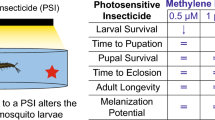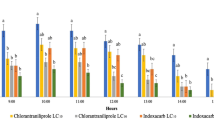Abstract
The toxic effect of hypericin (HYP), a photodynamic quinone that occurs in certain species of the genusHypericum, towardsManduca sexta third-instar larvae was investigated. The LD50 of purified hypericin was 16 μg/g larval initial fresh weight in constant light (22 W/m2). Reduced irradiance resulted in decreased mortality. Sublethal applications retarded larval growth (body fresh weight) in a dose-dependent manner. Toxicity had an absolute light dependence at the dose levels used, the active wavelengths being >500 nm. The phototoxic effect was rapidly lost when larvae were maintained in darkness (>8 hr) prior to irradiation. However, the potential for light-dependent mortality was retained if larvae were starved prior to irradiation.
Similar content being viewed by others
References
Arnason, T., Towers, G.H.N., Philogene, B.J.R., andLambert, J.D.H. 1983. The role of natural photosensitizers in plant resistance to insects, pp. 139–151,in P. A. Hedin (ed.). Plant Resistance to Insects. ACS Symposium Series No. 208, American Chemical Society, Washington, D.C.
Bell, R.A., andJoachim, F.A. 1978. Techniques for rearing laboratory colonies of tobacco hornworms and pink bollworms.Ann. Entomol. Soc. Am. 69:365–373.
Berenbaum, M.R. 1987. Charge of the light brigade: Phototoxicity as a defense against insects, pp. 206–216,in J.R. Heitz and K.R. Downum (eds.). Light Activated Pesticides. ACS Symposium Series No. 339, American Chemical Society, Washington, D.C.
Callaham, M.F., Broome, J.R., Poe, E.E., andHeitz, J.R. 1977. Time dependence of light independent biochemical changes in the Boll WeevilAnthonomus grandis caused by rose bengal.Environ. Entomol. 6:669–673.
Callaham, M.F., Broome, J.R., Poe, E.E., andHeitz, J.R. 1977. Time dependence of light independent biochemical changes in the Boll WeevilAnthoanomus grandis caused by rose bengal.Environ. Entomol. 6:669–673.
Champagne, D.E., Arnason, J.T., Philogene, B.J.R., Morand, P., andLam, J. 1986. Light-mediated allelochemical effects of naturally occurring polyacetylenes and thiophenes from Asteraceae on herbivorous insects.J. Chem. Ecol. 12:835–858.
Downum, K.R., andRodriguez, E. 1986. Toxicological action and ecological importance of plant photosensitizers.J. Chem. Ecol. 12:823–834.
Downum, K.R., Rosenthal, G.A., andTowers, G.H.N. 1984. Phototoxicity of the allelochemical, α-terthienyl, to larvae ofManduca sexta (L.) (Sphingidae).Pestic. Biochem. Physiol. 22:104–109.
Foote, C.S. 1976. Photosensitized oxidation and singlet oxygen: Consequences in biological systems, pp. 85–133,in W.A. Pryor (ed.). Free Radicals in Biology, Vol. II. Academic Press, London.
Giese, A.C. 1980. Hypericism.Photochem. Photobiol. Rev. 5:229–255.
Heitz, J.R. 1982. Xanthene dyes as pesticides, pp. 429–457,in J.R. Coats (ed.). Insecticide Mode of Action. Academic Press, London.
Knox, J.P., andDodge, A.D. 1985a. Singlet oxygen and plants.Phytochemistry 24:889–896.
Knox, J.P., andDodge, A.D. 1985b. Isolation and activity of the photodynamic pigment hypericin.Plant Cell Environ. 8:19–25.
Knox, J.P., Samuels, R.I., andDodge, A.D. 1987. The photodynamic action of hypericin, pp. 265–270,in J.R. Heitz and K.R. Downum (eds.). Light Activated Pesticides. ACS Symposium Series No. 339, American Chemical Society, Washington, D.C.
Lemke, L.A., Koehler, P.G., Patterson, R.S., Feyer, M.B., andEichhoff, T. 1987. Field development of photoxidative dyes as insecticides, pp. 156–167,in J.R. Heitz and K.R. Downum (eds.). Light Activated Pesticides. ACS Symposium Series No. 339, American Chemical Society, Washington, D.C.
Mclachlan, D., Arnason, T., Philogene, B.J.R., andChampagne, D. 1982. Anti-feedant activity of the polyacetylene, phenylheptatriyne (PHT), from the Asteraceae toEuxoa messoria (Lepidoptera: Noctuidae).Experientia 38:1061–1062.
Rees, C.J.C. 1969. Chemoreceptor specificity associated with choice of feeding site by the beetleChrysolina brunsvicensis on its food plantHypericum hirsutum.Entomol. Exp. Appl. 12:565–583.
Robinson, J.R. 1983. Photodynamic insecticides: A review of studies on photosensitizing dyes as insect control agents, their practical application, hazards and residues.Residue Rev. 88:69–100.
Rosenthal, G.A., andJanzen, D.H. 1979. Herbivores: Their Interaction with Secondary Plant Metabolites. Academic Press, New York.
Towers, G.H.N. 1984. Interactions of light with phytochemicals in some natural and novel systems.Can. J. Bot. 62:2900–2911.
Weaver, J.E. 1987. Physiological effects of photodynamic action: Special reference to insects, pp. 122–133,in J.R. Heitz and K.R. Downum (eds.). Light Activated Pesticides. ACS Symposium Series No. 339, American Chemical Society, Washington, D.C.
Author information
Authors and Affiliations
Rights and permissions
About this article
Cite this article
Samuels, R., Knox, P. Insecticidal activity of hypericin towardsManduca sexta larvae. J Chem Ecol 15, 855–862 (1989). https://doi.org/10.1007/BF01015181
Received:
Accepted:
Issue Date:
DOI: https://doi.org/10.1007/BF01015181




